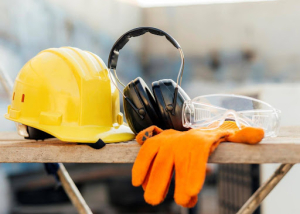The Importance of PPE in the workplace
Personal Protective Equipment (PPE) is of paramount importance in safeguarding workers’ health and well-being across various different industries. By providing essential protective gear such as helmets, gloves, goggles, and respirators, employers can significantly mitigate the risks posed by workplace hazards.
Did you know? Reports from the Health and Safety Executive (HSE) and The Labour Force Survey (LFS) a staggering 561,000 workers sustained non-fatal injuries during 2022/23 highlighting the critical need for effective training and PPE implementation. PPE serves as a crucial line of defence against physical, chemical, biological, and environmental hazards, reducing the likelihood and severity of injuries. Beyond regulatory compliance, the provision of adequate PPE demonstrates an employer’s commitment to worker safety, ensuring a culture of care and accountability in the workplace.
Investing in correct PPE not only protects employees from harm but also enhances productivity, morale, and overall organisational performance. In essence, prioritising PPE is essential for creating a safe and healthy work environment where workers can thrive without compromising their safety.
Why is the use of PPE important? Additionally, adherence to PPE regulations not only protects your employees from harm but also shields your company from legal liabilities and financial burdens associated with workplace accidents. Workers must use their PPE correctly and report any defects/damage to them for their own safety against risks. You must make sure to have the correct training and information on how to use the PPE as you strive to maintain a culture of safety and excellence, consider these as an investment in your most valuable asset – your workforce.
The Laws behind PPE: In the UK, the use of PPE in the workplace is governed by the Personal Protective Equipment at Work Regulations 1992. These regulations require employers to provide suitable PPE to employees who may be exposed to risks to their health and safety while at work, where such risks cannot be adequately controlled by other means.
Key provisions of the PPE Regulations include:
- Risk Assessment: Employers are mandated to conduct comprehensive risk assessments to pinpoint workplace hazards necessitating PPE usage. This evaluation determines the appropriate types of PPE required to effectively mitigate identified risks.
- PPE Selection: Employers are accountable for selecting suitable PPE that aligns with the specific risks identified during hazard assessments. The provided PPE must be pertinent to the nature of the job and the prevailing working conditions.
- Provision of PPE: Employers must provide employees with the necessary PPE free of charge. This includes ensuring that PPE is in good working order, properly maintained, and replaced when necessary.
- Training and Guidance: Training is vital, and Employers must offer adequate training and guidance to employees on the proper use, maintenance, and storage of PPE. Employees should be aware of when and how to use PPE correctly and understand its limitations.
- Compatibility: Employers must verify that the provided PPE is compatible with other protective equipment or clothing worn by employees. This ensures the effectiveness of the PPE and does not impede other safety measures.
- Information and Instruction: Employers must provide employees with information and instruction on the risks present in the workplace, the purpose and use of PPE, and any limitations or restrictions associated with its use.
- Assessment of PPE: Employers must periodically review and assess the effectiveness of the PPE provided to ensure that it continues to provide adequate protection against identified risks.
Non-compliance with the PPE Regulations may lead to enforcement measures by the Health and Safety Executive (HSE), such as fines and legal proceedings. Hence, it is imperative for employers to grasp their responsibilities outlined in the PPE Regulations and implement suitable measures to safeguard the health and safety of their workforce. Visit our partners, – leaders in fashionable footwear!
PPE plays a crucial role in protecting workers from various hazards in the workplace, but let’s not forget the importance of training in those working environments, from ‘Confined spaces’, or ‘Working at height’.
Here’s an overview of some common types of PPE and their importance:
- Safety Glasses/Goggles/Face Shields: Eye and face protection from flying debris, chemical splashes, and other hazards that could cause eye injuries or facial injuries.
- Hard Hats: Provide head protection from falling objects, electrical hazards, and bumps to the head, reducing the risk of head injuries such as concussions or skull fractures.
- Earplugs/Earmuffs: Reduce exposure to loud noise levels, preventing hearing loss or damage from prolonged exposure to high decibel levels.
- Respiratory Protection: Protect the respiratory system from inhaling harmful airborne contaminants such as dust, fumes, gases, vapours, and biological agents, safeguarding against respiratory illnesses and diseases.
- Gloves: Shield the hands from cuts, abrasions, burns, chemical exposures, and other hazards, preventing injuries and skin damage.
- Safety Shoes/Boots: Safety footwear and foot protection from falling objects, punctures, electrical hazards, slips, trips, and other potential foot injuries, ensuring stability, and preventing foot-related injuries.
- Protective Clothing/Coveralls: Cover the body to protect against chemical spills, exposure to hazardous substances, extreme temperatures, and other workplace hazards, minimising skin contact and reducing the risk of chemical burns, skin irritation, or contamination.
- Harnesses and Fall Protection: Prevent falls from heights by securing workers to anchorage points, ensuring their safety when working at elevated locations such as roofs, scaffolding, or platforms.
- High-Visibility Clothing/Vests: Enhance visibility in low-light conditions or areas with moving equipment or vehicles, reducing the risk of accidents and improving worker safety, especially in construction, roadwork, or transportation settings.
Both Training and PPE serve a specific purpose and are essential for safeguarding workers from different workplace hazards. Proper selection, use, maintenance, and training are critical to ensuring its effectiveness in protecting workers’ health and safety. Employers should assess workplace hazards, provide appropriate PPE, and ensure that employees are trained on its proper use to minimise the risk of injuries and illnesses.
PPE serves as an indispensable element of workplace safety, providing crucial protection against diverse health and safety risks. Through meticulous selection, proper utilisation, and consistent maintenance of PPE, you can ensure a secure and healthy work environment conducive to employee well-being and productivity.
Experience the difference with PLT Training, your premier one-stop-shop for all your health and safety training needs. As highlighted, the importance of Personal Protective Equipment cannot be overstated, especially considering the staggering number of non-fatal injuries reported. Our mission is to provide high-quality training that promotes a positive and safe working culture, ultimately ensuring the well-being of your workforce. By investing in proper PPE and comprehensive training, you not only protect your employees from harm but also enhance productivity and reduce costs associated with workplace incidents.
Let PLT Training be your partner in creating a safer and more efficient workplace. Contact us today to learn more about our accredited training programs and take the first step towards a safer tomorrow.





